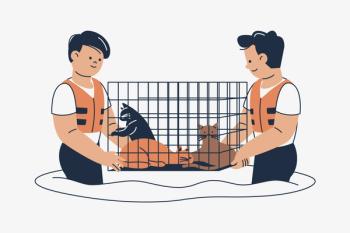
EU standards could signal new challenges for veterinary records, horse transport and slaughter
National Report - Since it's 2008 ban, America has exported the job of equine slaughter to its neighbors to the north and south - Canada and Mexico, both of which have cited increases in slaughter rates over the last three years.
National Report — Since it's 2007 ban, America has exported the job of equine slaughter to its neighbors to the north and south — Canada and Mexico, both of which have cited increases in slaughter rates over the last three years.
But all that may soon change when a new European Union (EU) requirement, designed to safeguard horse meat exported to Europe for human consumption, will restrict the sale of meat from horses who have been given certain drugs that are unsafe in the food supply.
Effective July 31, 2010, the EU will not accept imported horse meat from countries like Canada and Mexico unless it can prove that certain drugs and steroids were not ingested by the horse within six months of slaughter. By 2013, the EU rule will require each slaughtered horse to be shipped with an Equine Identification Document (EID) — a detailed electronic log of a horse's lifetime veterinary record and the drugs it has been given. A number of drugs — including, but not limited to phenylbutazone, testosterone, common dewormers and some antibiotics — must not have been given to the horse in at least the last 180 days prior to slaughter or they can not be imported into EU nations.
This could mean big problems for the United States — especially if Canadian and Mexican slaughterhouses stop accepting its unwanted horses.
How big is the problem?
Since the last of the United States equine slaughterhouses closed in 2007 at the urging of humane organizations, another problem has emerged, and some industry reports indicate that slaughter of United States horses at plants in Mexico and Canada at are an all-time high.
Prior to slaughterhouses closing in 2007, it was estimated that the United States processed about 100,000 horses per year.
The number of United States horses slaughtered in Canada rose about 13 percent after the last domestic plant closed, reports the Animal Law Coalition. Other agencies report similar numbers.
According to a report compiled by the Equine Welfare Alliance and the Canadian Horse Defence Coalition (CHDC), about 50,000 horses were slaughtered in Canada in 2006, resulting in more than $20 million in revenue. In 2008, the year after the last United States slaughterhouse closed, that number jumped to nearly 113,000 and more than $109 million in revenue. By 2009, numbers had decreased to about 94,000 horses — down from the year before, but still well above the 2006 level. Additionally, only about 35 percent of horses slaughtered in Canada were imported from the United States, compared to nearly 60 percent by 2009, according to the report.
In Mexico, similar increases have been noted. A report by the American Veterinary Medical Association found that from December 2006 to December 2007, the number of horses shipped to Mexico for slaughter rose from nearly 11,000 to more than 44,000 — an increase of more than 300 percent. Exports for other reasons, like breeding and recreation, also increased, "raising concerns that many of these horses are actually being sent to slaughter, but shipped under false pretenses," AVMA says.
In addition to the number of horses sent to slaughter, there is the big question of exactly how big the unwanted horse problem today.
A July 2009 survey by the Unwanted Horse Coalition found that 90 percent of respondents believed the number of unwanted, neglected and abused horses was increasing. Almost 90 percent called the unwanted horse issue a "big problem," compared with only 22 percent prior to the shutdown of stateside equine slaughterhouses. A majority of equine rescue and retirement facilities are at full capacity, and many respondents blamed the closure of U.S. plants, the economy, and the high cost of euthanasia and disposal for the growing crisis. Aside from educating horse owners and funding rescue operations, many of the survey respondents — consisting of horse owners, veterinarians, trainers, breeders and more — favored reopening slaughterhouses as a means to curb the number of unwanted horses.
How will an EU requirement affect the United States?
A more vexing question is what will happen if the United States' neighbors stop accepting its horse exports?
Horse meat for human consumption is a big industry in Canada. The majority of the horse meat exports produced there — 92 percent — are sent to France, Switzerland, Japan and Belgium. In total, Canada exported horse meat to 24 countries in 2009.
To meet the new EU requirement, the Equine Welfare Alliance and the Canadian Horse Defence Coalition say the country will require an EID/electronic passport for every horse presented for slaughter starting on July 30, 2010. By 2011, the Canadian government committed to instituting a mandatory comprehensive national traceability system for livestock.
These new requirements could have great consequences for U.S. horses bound for Canadian slaughterhouses, according to the report.
"We know that 50 percent or more of the horses slaughtered in Canada (from the United States) will not meet the EU standards. ... Those 47,000 horses from the United States going to slaughter in Canada in 2010 will originate from livestock auctions where horses all have virtually unknown history," states a March 2010 report from the Equine Welfare Alliance and the Canadian Horse Defence Coalition. "There is no information from the Canadian Food Inspection Agency (CFIA) stating how U.S.-based horses will be checked. ... Under the current circumstances there appears to be no possible way Canada can continue to receive U.S. horses and still meet the criteria."
Additionally, there have been concerns about humane slaughter in Canada at several of the major equine slaughterhouses, resulting in investigations by CFIA and a call by some legislators to end horse slaughter for human consumption in Canada. Canadian Parliament member Alex Atamanenko proposed a bill that would shut down slaughterhouses for human consumption.
"The fact is that drugs that are prohibited for use during the life of any animal destined for the human food supply are routinely being administered to horses," Atamanenko says in a statement about the bill on his Web site. "It is irresponsible for Canada to allow the sale of meat from horses as a food item when they have never been raised in accordance with the food-safety practices required for all other animals.
"Many in the United States believe it should be our job to verify information from U.S. horses since Canada is the only one slaughtering them for human consumption. It's a stretch to think that information on hundreds of thousands of unwanted horses, that were never raised to be food, will be complete or accurate."
What would stopping horse exports mean to the unwanted horse problem?
Without firm numbers of exactly how many unwanted horses there are in the United States, it is difficult to estimate what it would mean if thousands of horses previously exported for slaughter suddenly stayed within U.S. borders.
Ericka Caslin, director of the Unwanted Horse Coalition, says the group is watching the issue, but does not usually take a position on slaughter legislation issues. However, Caslin says study findings from a report commissioned by Congress from the United States Government Accountability Office already have been delayed because of the enormous reach of the problem. The study, commissioned in late 2009 for release in March 2010, was to look into how the horse industry has been affected by the 2007 closure of horse slaughter plants. It was also meant to study how the transport of horses destined for slaughter in Canada and Mexico is monitored and any other conclusions regarding the state of equine welfare in the wake of the ban on horse slaughter for human consumption in the United States
Once work on the study began, however, Caslin says it became clear that the issue was bigger than initially suspected, and now results are not expected until early 2011.
A federal bill introduced in January 2009, called the Prevention of Equine Cruelty Act, has been at a stand-still since March 2009, when it was sent to the House of Representatives and Senate committees, but several states are looking to take matters into their own hands.
California lawmakers are considering a bill that would support the federal proposal to make horse slaughter for human consumption illegal, while Florida legislators are considering making the distribution or sale of horse meat for human consumption a felony. Many other states considering laws, however, are on the other side of the fence. Illinois, Idaho, Kentucky, Missouri, Oklahoma, South Dakota and Wyoming all have proposed or passed bills urging U.S. lawmakers to reconsider funding inspections of horse slaughter plants. Illinois is split, however, with lawmakers considering proposals both to remove the prohibition on horse slaughter and oppose the continuation of any horse slaughter in the United States. Some states even have ordered feasibility studies for establishing horse processing facilities in their states.
Newsletter
From exam room tips to practice management insights, get trusted veterinary news delivered straight to your inbox—subscribe to dvm360.




